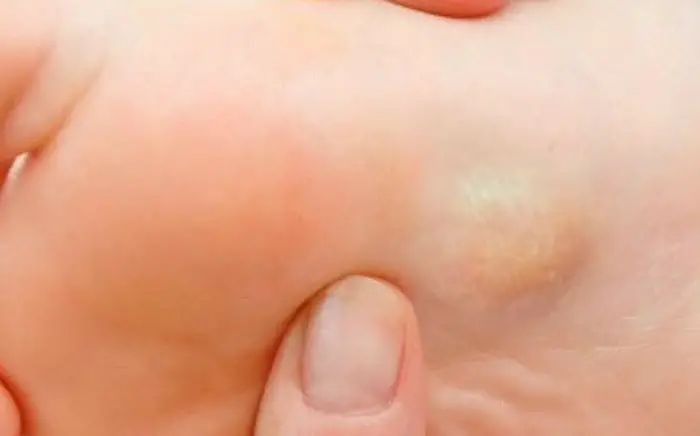LUMPS IN THE ARCH OF THE FOOT
What is Plantar Fibroma?
A plantar fibroma is a noncancerous or benign growth in the arch of your foot. It develops in the plantar fascia, which is thick, fibrous tissue at the bottom of your feet. This tissue covers the area from your heel to your toes and stabilizes your foot arch.
This nodule, which grows slowly over time, can develop on one foot or both feet. It’s typically less than an inch in size.
A single lesion is referred to as a plantar fibroma. A condition called plantar fibromatosis can develop if the lesion starts to enlarge and others develop on the plantar aspect, or sole, of your foot. This rare condition is also known as Ledderhose disease.
Although anyone can develop a plantar fibroma, it typically occurs in middle age. Men are also more likely to be affected.

What Causes Plantar Fibroma?
The exact cause of a plantar fibroma is unknown, although some experts suspect a genetic component. For example, there is a higher rate of fibrotic conditions in people of Northern European descent.
Some researchers also believe there’s a connection between trauma and plantar fibromas. An injury may cause tears in the fascia of the bottom of your feet, promoting the growth of nodules.
Certain medications and supplements may also encourage the growth of excess collagen and fibrous tissue, but this hasn’t been proven. These include:
- certain beta-blockers to treat high blood pressure
- anti-seizure medications
- vitamin C
- glucosamine
You may also be more likely to develop plantar fibroma if you have:
- chronic liver disease
- diabetes
- seizure disorders
The connection between these conditions and plantar fibroma is unclear.
Because it isn’t clear what exactly causes plantar fibroma or why there’s no known way to prevent its occurrence.
Plantar Fibroma Diagnosis
At your appointment, your doctor will conduct a physical examination of your foot. This includes pressing the nodule.
Although it’s possible to diagnose a plantar fibroma based on the appearance of the nodule, your doctor may recommend additional testing.
Imaging tests can confirm a plantar fibroma and rule out other conditions, such as cysts, granulomas, and malignancies.
Possible imaging tests include:
At your appointment, your doctor will conduct a physical examination of your foot. This includes pressing the nodule.
Although it’s possible to diagnose a plantar fibroma based on the appearance of the nodule, your doctor may recommend additional testing.
Imaging tests can confirm a plantar fibroma and rule out other conditions, such as cysts, granulomas, and malignancies.
Possible imaging tests include:
- X-ray
- MRI scan
- bone scan (if it’s thought a tumor has spread to the bone)
Sometimes doctors perform a biopsy of the lesion for further investigation. This involves removing a sample of the tissue and examining the sample under a microscope.
Plantar Fibroma Treatment
Transdermal verapamil 15 percent gel inhibits the growth of fibrosis tissue in the laboratory. When used correctly, it’s claimed that this gel can remodel the affected tissue within 6 to 12 months. However, scientific evidence for this claim is very limited. Any pain or discomfort usually subsides within 3 months of use if this medication is helpful to a particular user.
The manufacturer of the drug states that skipping or missing doses can slow the rate of recovery, so be sure to follow your doctor’s directions. After the tissue has been remodeled, recurrence is unlikely.
A corticosteroid is an anti-inflammatory medication. Injecting a steroid into the nodule can reduce pain and inflammation. If the inflammation lessens, it may become easier to walk, stand, and wear shoes.
Although steroid injections are effective in relieving any inflammatory process, the nodule may continue to grow.
Orthotics For Plantar Fibroma
Orthotics may be beneficial if the growth is small and hasn’t changed in size. This nonsurgical treatment involves the use of gel or foam pads and insoles to redistribute body weight and relieve pain associated with a plantar fibroma. Although their usefulness is questionable, there is no risk to trying them.
As a result, wearing shoes and standing may become more comfortable. If over-the-counter insoles aren’t improving your symptoms, talk to your doctor about custom options. However, the usefulness of custom orthotics has also been questioned.
Physical therapy for Plantar Fibroma
Physical therapy helps break tissue accumulation in the foot. Your physical therapist will help you develop a routine of strength training and stretching exercises that can help increase blood circulation and stimulate cell growth. Increased circulation can also reduce inflammation and relieve pain caused by a plantar fibroma. There are no published studies that show that physical therapy has a significant beneficial effect in the treatment of plantar fibromas, however.
Plantar Fibroma Surgery
In severe cases, your doctor may suggest surgical removal of the fibroma. This procedure can flatten your foot arch and increase your risk of hammertoe, so this procedure is only used as a last resort. On average, recovery can take one to two months.
Our Docters
Our Board Certified Podiatrists
Socal Foot and Ankle doctors are committed to delivering the most exceptional treatments.

Board Certified Foot & Ankle Specialist
Office Time
Location: Santa Monica
Mon – Thur: 9:00 AM – 5:00 PM
Friday: 9:00 AM – 5:00 PM

Board Certified Foot & Ankle Specialist
Office Time
Location: Santa Monica
Mon – Thur: 9:00 AM – 5:00 PM
Friday: 9:00 AM – 5:00 PM
Request Appointment
NON-INVASIVE ADVANCED TREATMENT
BOARD CERTIFIED
FOOT & ANKLE
Surgeons
Years Experience
Happy Patients
Location
Local Partners
